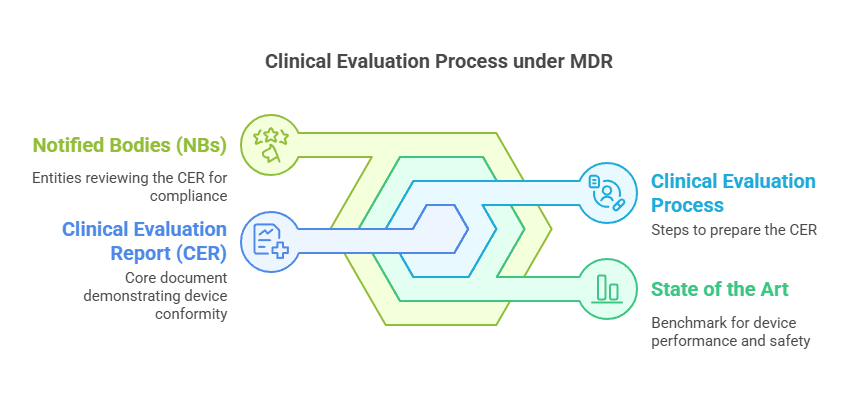Top 5 Insights for Building a Strong Clinical Evaluation Strategy Under EU MDR
The EU MDR 2017/745 has raised the bar—permanently. It’s no longer enough to tick off checkboxes. You need a well-structured, evidence-driven clinical evaluation strategy that evolves throughout the device lifecycle.
And while the regulations are complex, they also offer clarity—if you know where to look.
Whether you’re just starting or already navigating post-market challenges, refining your strategy is vital. This guide will help you understand what matters most, why it matters, and how to get it right—right from the start.
Understanding the Clinical Evaluation Mandate under EU MDR
The EU MDR 2017/745 mandates a continuous and proactive approach to clinical evaluation. No more one-time efforts. Instead, your clinical evaluation must:
Be ongoing across the product lifecycle
Integrate real-world performance and safety data
Support clinical benefit through measurable evidence
That means reactive strategies are no longer viable. You need a plan—clear, data-driven, and aligned with your device’s intended purpose.
Start with a Crystal-Clear Intended Purpose
Your intended purpose is the backbone of your clinical evaluation. It tells regulators (and your team) exactly what your device is designed to do.
✅ Is it specific?
✅ Is it supported by your labeling and IFUs?
✅ Is it free from marketing jargon?
Example:
“To monitor glucose levels in adult diabetic patients through continuous subcutaneous sensing.”
When this definition is clear and consistent across documentation, you prevent gaps that can trigger review delays or rejections.
Avoid the Risk of Misalignment Across Documents
Inconsistencies are red flags. Here’s a common issue:
CEP says the device is for “all patients.”
IFU mentions adults only.
Clinical studies cover ages 18–65.
This type of misalignment can derail your review. Notified bodies will ask: “Which population does your data actually support?”
Solution? Use a unified message across:
Clinical Evaluation Plan (CEP)
Instructions for Use (IFU)
Clinical trial documentation
All materials should reflect the same scope, population, and claims.
Define Measurable Outcome Parameters
Subjective claims won’t cut it anymore. EU MDR demands quantifiable clinical evidence. Your strategy must include:
Safety outcomes – e.g., adverse events, infection rates
Performance outcomes – e.g., healing time, sensor accuracy
Set clear thresholds and benchmarks. For example:
| Parameter | Target Benchmark |
|---|---|
| Infection Rate | <3% |
| Healing Time | <14 Days |
| Allergic Reactions | <1% |
Compare these metrics with State of the Art (SOTA) data to demonstrate equivalence or superiority.
Tell a Consistent Clinical Story
Once your data is in place, the next step is strategic storytelling.
Ask yourself:
Does the evidence support both safety and performance?
Does it reflect the real-world use of the device?
Are risks identified and addressed?
Are benefits meaningful and measurable?
Structure matters. Your evaluation report should follow a logical flow, moving from intended purpose to evidence, to conclusions—with no gaps in between.
Keep Your Strategy Alive Post-Market
Post-market surveillance isn’t just a checkbox—it’s an ongoing validation tool for your clinical evaluation.
Feed post-market data back into your:
Clinical Evaluation Report (CER)
Post-Market Clinical Follow-up (PMCF)
Risk Management File
This proactive loop is key to maintaining compliance, supporting future design changes, and protecting patient safety.
Final Thoughts: Strategy Is the New Compliance Superpower
Success under EU MDR depends on one thing: a proactive clinical evaluation strategy. It’s not just about meeting requirements—it’s about de-risking your market access, improving patient outcomes, and speeding up regulatory approvals.
Let’s recap the essentials:
Define your intended purpose clearly
Align your documents consistently
Set measurable, evidence-based outcome parameters
Compare to SOTA benchmarks
Tell a cohesive clinical story
Close the loop with post-market data
These aren’t just compliance steps—they’re strategic levers for growth and trust.
FAQs about Clinical Evaluation Strategy
What is a clinical evaluation strategy?
It’s a structured plan to gather, assess, and present clinical evidence to support your device’s safety and performance.
Why is it important under EU MDR?
Because MDR demands continuous evaluation, not one-time reviews. Your strategy ensures you stay compliant and market-ready.
How often should I update my clinical evaluation?
Regularly—especially after receiving post-market data, changing your device, or entering a new market.
How does clinical evaluation differ from PMCF?
Clinical evaluation is broader and ongoing. PMCF is a subset, focused on collecting post-market performance data.
What happens if my strategy is inconsistent?
Notified bodies may reject your submission or request extensive revisions, delaying your market access.
Can I outsource my clinical evaluation?
Yes, but you still remain legally responsible. Ensure external experts align with your regulatory strategy and device understanding.
Subscribe for Expert Guidance on Clinical Evaluation Strategy
Want deeper insights and exclusive content?
Subscribe to my newsletter for expert tips, templates, and regulatory updates you won’t find anywhere else.
You’ll get access to:
Private articles and templates
Real-world case studies
CE marking strategy updates
Invitations to live Q&As
Related Resources on Clinical Evaluation Strategy
✌️ Peace,
Hatem Rabeh, MD, MSc Ing
Your Clinical Evaluation Expert & Partner
Follow me for more practical insights and strategies!





